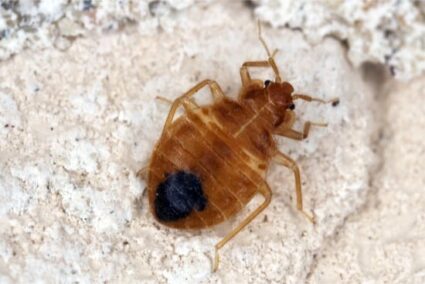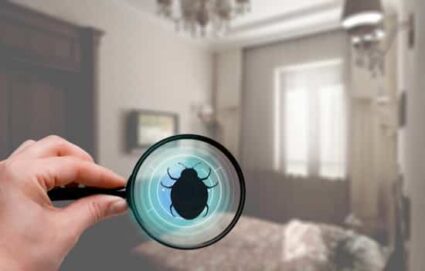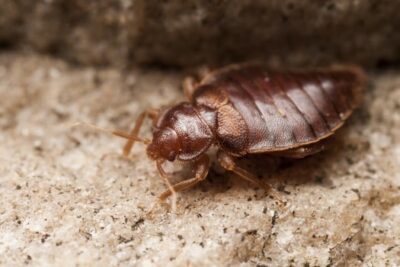There are two kinds of parasites: those that feed on their host’s skin or blood, and those that live near them, eating crumbs and anything similar that the host leaves behind. Cockroaches are the most obvious example that falls in the latter camp. But what about bed bugs?
Bed bugs have evolved to only eat blood from humans, but also from other mammals. Their mouth is like a straw. Bed bugs don’t have teeth or a tongue to chew with, so they can’t eat any other food.
Imagine if you had just a straw instead of a mouth—you would only eat soup and other similar, liquid foods. It’s the same for bed bugs, with no exceptions as to species. The exact same is true for Cimex adjunctus just as it is for Cimex lectularius and Cimex hemipterus.
Do Bed Bugs Only Feed on Blood?
Everybody knows that bed bugs feed on blood. But there are regular stories of bed bug infestations that survive for more than a year, even without a host. So, surely they’re eating something else? Let’s find out what bed bugs eat other than blood.
Do Bed Bugs Eat Each Other?
Bed bugs are renowned for being able to survive in the absence of a host for years at a time. If the house is empty, that means there aren’t any people or pets for them to feed on. There aren’t even any crumbs that they might be able to eat. So do bed bugs survive in these conditions by eating each other?
No, bed bugs don’t eat each other. This kind of behavior isn’t normal in any sort of population, because it decreases the number of individuals that are available to mate. Any species that regularly eats its own kind is likely to die out soon enough.
They don’t feed on ‘bed bug blood’, either. Insects don’t have blood like humans. According to Scientific American, they have a different fluid called ‘hemolpymh’, which is different in a few ways (it doesn’t contain hemoglobin, for example). And, obviously, they don’t have as much. This makes it unsuitable for bed bugs to eat. In fact, the bed bugs that feed on us can only feed on the blood of mammals.
Do Bed Bugs Eat Food Crumbs?
Many pests survive in people’s homes by eating from the trash, from food that’s left out, or just from crumbs that were brushed to the floor. The most obvious example is obviously the cockroach. A cockroach can live for months on nothing but tiny crumbs that you wouldn’t even notice—and heaven forbid that you leave some food out, because there’ll be a big group of them all over it.
Do bed bugs feed on crumbs too? No, they don’t. You can test it yourself. Leave some crumbs out on a plate in a heavily infested house and see if the bed bugs try to eat them. There might be some that clamber over the plate, but they won’t crowd there, and they won’t eat it.
Do Bed Bugs Eat Dead Skin?
You might already know that there are tiny insects that feed solely on dead skin. Dust mites, as they’re known, are small enough that you can’t see them with the naked eye. They live in carpets and around your house, feeding on dust (dead skin). So do bed bugs do the same to survive?
No, bed bugs don’t eat dead skin. While there are some parasites that do tend to eat dead skin and similar tiny crumbs, these insects specialize to be able to do that. Bed bugs are specialized in a different way: so that they can only eat blood. Their mouth is shaped a certain way so that it can only feed on blood; not anything that needs chewing before swallowing.

Do Bed Bugs Eat Your Hair?
People who have severe bed bug infestations complain that they get everywhere, including in your hair. Some are so worried that they think they can feel bed bugs in their hair throughout the day. This has a few implications: does it mean that they can live in your hair, or does it mean they can actually eat your hair?
No, bed bugs don’t eat hair. Their mouth is the wrong shape to be able to feed on hair. Besides, there aren’t any parasites that feed specifically on hair. Fleas and mites that live in hair feed on blood from your scalp, not the hair itself. It wouldn’t make sense for these parasites to eat hair, because if they did, they’d be eating their habitat. The only exception is cockroaches, which can feed on dead hair and skin.
Bed bugs find it difficult to crawl through skin and hair anyway, let alone eat hair. They much prefer finding open patches of skin to feed on rather than anything covered in hair. That’s why you’ll have far more bites along your back rather than on your scalp (unless your head is shaved).
Do Bed Bugs Eat Wood?
Since bed bugs live close by to their host, not on them, they can hide in any number of environments. This includes inside walls and inside furniture. Not only that, but other pests (cockroaches especially) can feed on things as varied as glue, paper, and dead insects. So, is it possible that they can feed on wood or other similar materials like plastic or metal?
No, they can’t. While bed bugs can hide in the cracks in furniture, or in the walls, they can’t eat wood. All they’ll do is hide as deeply as they can in any crack, especially on the underside of the furniture, and wait until they feel like feeding again. During this time, they’ll be completely inactive. They won’t move around, they won’t feed on you, and they won’t feed on the wood either.
Do Bed Bugs Eat Roaches (Or Other Insects?)
So, bed bugs don’t eat other bed bugs or feed on other bed bugs. But what about other insects? There are plenty of insects that eat other bugs, like cockroaches—which, according to the New York Times, eat bed bugs. But can bed bugs feed on roaches or some other kind of insect?
No, they can’t. Aside from the fact that they couldn’t survive on eating roaches (they need blood to survive), bed bugs also couldn’t get a roach to be still enough for long enough for them to feed. Bed bugs much prefer for their host to be still, which is why they wait until you’re asleep. If you move, like when you roll over in the night, they’ll scatter. You can imagine how difficult it would be for a bed bug to feed on a roach.
If you didn’t know, bed bugs evolved from ‘bat bugs’. When humans started living in caves, some bed bugs discovered that we were actually easier to feed on and had more ‘food’ in us than bats do. They came with us when we started living in houses instead. Today’s bed bugs are basically the same as bat bugs. Bed bugs can only feed on mammals like humans, not insects.
What Do Bed Bugs Eat and Drink?
Animals often need to drink as well as eat. Obviously, we do—and so do other mammals like cats, dogs and similar. So what about bed bugs, do they need to drink regularly as well as eating?
They don’t, because they get more than enough fluid from your blood. Bed bugs are actually experts at holding onto moisture, because they have an external waxy layer to their shell that stops any moisture from evaporating from their shell.
And as for what they eat, there’s only one answer. Rather than list any more things that bed bugs don’t eat, let’s be clear: bed bugs only eat blood. Bed bugs are ‘hematophagous’, which means that they eat only blood. If you didn’t know, blood is actually highly rich in nutrients, proteins, and fats, which make it the perfect food for small insects that would prefer to feed infrequently. Other hematophagous insects include mosquitos, vampire bats and certain kinds of butterfly.
The fact that blood is so rich in nutrients means that they can live for a long time without feeding.
How Long Can Bed Bugs Live Without Feeding?
Bed bugs are renowned for being able to survive even when there’s no host around. And given that we’ve established that they don’t eat anything other than blood, that means they must be able to survive with no food for an exceptionally long time. But how long?
Bed bugs can survive in the absence of a host for a year or more. During this time, they don’t eat or drink anything to get by—they just wait. They can live for so long for two reasons. First, they’re excellent at conserving moisture at most temperatures. The waxy outer lining of their shell stops moisture from getting in or out, like the lining of a windbreaker. And being insects, they don’t need much water in their system as it is.
They can also survive for long periods without food because they use most of the nutritional content of their ‘meals’ to grow rather than just to survive. Bed bugs feed before they grow from one life stage (also known as an instar) to another. Between meals, they digest and wait. Once they’re fully grown, they’ll need to feed less often as there’s less need for nutrients.
Why do Bed Bugs Only Eat Blood?
So, bed bugs can only eat blood. But why? It would be exceptionally convenient for them to be able to feed on other things. They would be able to survive long periods without a host, for a start.
Bed Bugs Evolved from Bat Bugs
Bed bugs evolved from what we call ‘bat bugs’. These are insects in the same genus (Cimex) as bed bugs. They’re basically the exact same as bed bugs, except they live in caves and feed on bats instead of people. Many thousands of years ago, when humans first started living in caves, these bat bugs discovered that humans were much better to feed on than bats:
- We have more blood in us than bats do, so we can support bigger populations of bed bugs than bats can
- We aren’t as hairy or furry as bats are, so they find it easier to bite us
- We’re very still at night while we sleep—much more still than bats are
- We don’t preen ourselves as much as bats do, and we don’t eat insects like bats do either
Because we were so perfect for these bat bugs, they started feeding on us more. The original bat bugs, as well as the ones that still exist today, need bat blood in order to reproduce. This was originally the way it was for the first human bed bugs, too. But over time they lost that need, and can reproduce after feeding on human blood too. That’s the only difference, though: even a skilled entomologist (insect scientist) can’t tell them apart just by looking at them.
So, what’s the point of all this? Well, all of this is to say that bed bugs evolved from an older species which has always eaten blood, too. There’s no other food in caves for the bat bugs to eat—they live solely on blood. Bed bugs haven’t felt the need to learn how to eat anything else ever since then.

Bed Bug Mouth Parts
Bed bugs don’t have lips, teeth, cheeks or a tongue. They have what looks like a long beak or snout at the tip of their head; it’s as long as a leg, so to keep it out of the way, they fold it underneath themselves. They also have another, shorter tube right next to the longer one. The long beak is for sucking the blood, and the short one is for them to inject anesthetic saliva into the bite area.
Needless to say, this means they can’t chew or eat anything else. Imagine if we didn’t have any teeth, a tongue, or even lips: how difficult would it be to eat? And to make matters more complicated, instead of having a big opening for a mouth like we do now, what if we just had a straw? When you think of it that way, it’s obvious why they only eat blood.
How Do Bed Bugs Eat?
First, they’ll make a small incision. They’ll then simultaneously insert both of the tubes into your skin: the short one to stop it from hurting and itching, and the long one to find a capillary. They’ll move the longer tube around to try and find a capillary, and they’ll start sucking up your blood.
Feeding normally takes between ten and twenty minutes. If at any point you move or try and brush them away in your sleep, they’ll quickly scatter to get away from you. Unlike fleas and cockroaches, bed bugs are easy to squash and kill, so they’re more careful than other parasites. If they feed successfully, they’ll become two to three times their previous size because they’re filled with blood.
After they eat, they’ll head back to their hiding place to digest, and if necessary, grow to their next life stage. Because their feeding tube is very thin, the incision they make heals quickly.
But the saliva they leave behind to stop the wound itching wears off eventually, because your body recognizes it and gets rid of it. This is what causes the allergic reaction to bed bug bites, i.e. the raised, itchy bumps you get from one.
How Often Must Bed Bugs Eat?
How long does it take for bed bugs to die without a host? Bed bugs can survive for a year or more without feeding on a host. So, in one way, you could say that bed bugs must feed at least once a year. However, they will feed much more frequently than this if they have access to a host. Most bed bugs will eat every five to ten days as they grow, as they continue to breed and grow the infestation.
Once fully grown, bed bugs don’t need blood in order to get to their next life stage, so they slow down—but just a little. They still need nutrients in order to mate and produce eggs, which will take up most of their time when they’re adults. Once every ten days to two weeks is normal.
Bed bugs are also known to increase the frequency of their feeds during warmer months. This is because the warmer weather aids their digestion, meaning that they can grow to their next stage more quickly. Once at their next stage, they then need to feed again. In these warm conditions, a bed bug may feed just once every two or three days. The reverse is true during the colder seasons, when bed bugs may only feed once every month.

